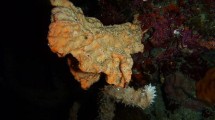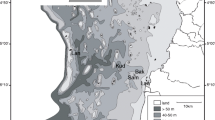Abstract
In this study we performed a survey of the bacterial communities associated with the Western Atlantic demosponges Hymeniacidon heliophila and Polymastia janeirensis, based on 16S rRNA sequencing and transmission electron microscopy (TEM). We compared diversity and composition of the sponge-associated bacteria to those of environmental bacteria, represented by free-living bacterioplankton and by bacteria attached to organic particulate matter in superficial sediments. Partial bacterial 16S rRNA sequences from seawater, sediment, and sponges were retrieved by PCR, cloning, and sequencing. Sequences were subjected to rarefaction analyses, phylogenetic tree construction, and LIBSHUFF quantitative statistics to verify coverage and similarity between libraries. Community structure of the free-living bacterioplankton was phylogenetically different from that of the sponge-associated bacterial assemblages. On the other hand, some sediment-attached bacteria were also found in the sponge bacterial community, indicating that sponges may incorporate bacteria together with sediment particles. Rare and few prokaryotic morphotypes were found in TEM analyses of sponge mesohyl matrix of both species. Molecular data indicate that bacterial richness and diversity decreases from bacterioplankton, to particulate organic sediment, and to H. heliophila and P. janeirensis. Sponges from Rio de Janeiro harbor a pool of novel and exclusive sponge-associated bacterial taxa. Sponge-associated bacterial communities are composed of both taxons shared by many sponge groups and by species-specific bacteria.





Similar content being viewed by others
References
Althoff K, Schütt C, Steffen R, Batel R, Müller WEG (1998) Evidence for a symbiosis between bacteria of the genus Rhodobacter and the marine sponge Halichondria panicea: harbor also for putatively toxic bacteria? Mar Biol (Berl) 130:529–536. doi:10.1007/s002270050273
Andrade L, Gonzalez AM, Araújo FV, Paranhos R (2003) Flow cytometry assessment of bacterioplankton in tropical marine environments. J Microbiol Methods 55:841–850. doi:10.1016/j.mimet.2003.08.002
Bergquist PR (1978) Sponges. Hutchinson, London
Boury-Esnault N (1973) Résultats Scientifiques des Campagnes de la “Calypso”. Campagne de la “Calypso” au large des côtes atlantiques de l’Amérique du Sud (1961–1962). I. 29. Spongiaires. Ann Inst Oceanograph 49(Suppl. 10):263–295
Boury-Esnault N, Hajdu E, Klautau M, Custodio M, Borojevic R (1994) The value of cytological criteria in distinguishing sponges at the species level: the example of the genus Polymastia. Can J Zool 72(5):795–804
Cerrano C, Calcinai B, Camillo CG, di Valisano L, Bavestrello G (2007) How and why do sponges incorporate foreign material? Strategies in Porifera. In: Custódio MR, Lôbo-Hajdu G, Hajdu E, Muricy G (eds) Porifera research: biodiversity, innovation, sustainability. série livros 28. Museu Nacional, Rio de Janeiro, pp 239–246
Cervino JM, Winiarski-Cervino K, Polson SW, Goreau T, Smith GW (2006) Identification of bacteria associated with a disease affecting the marine sponge Lanthella basta in New Britain, Papua New Guinea. Mar Ecol Prog Ser 324:139–150. doi:10.3354/meps324139
Cole JR, Chai B, Marsh TL, Farris RJ, Wang Q, Kulam SA et al (2003) The Ribosomal Database Project (RDP-II): previewing a new autoaligner that allows regular updates and the new prokaryotic taxonomy. Nucleic Acids Res 31:442–443. doi:10.1093/nar/gkg039
Edwing B, Hillier L, Wendl M, Green P (1998) Basecalling of automated sequencer traces using phred I accuracy assessment. Genet Res 8:175–185
Fieseler L, Horn M, Wagner M, Hentschel U (2004) Discovery of the novel candidate phylum Poribacteria in marine sponges. Appl Environ Microbiol 70:3724–3732. doi:10.1128/AEM.70.6.3724-3732.2004
Folmer O, Black M, Hoeh W, Lutz R, Vrijenhoek R (1994) DNA primers for amplification of mitochondrial cytochrome C oxidase subunit I from diverse metazoan invertebrates. Mol Mar Biol Biotechnol 3:294–299
Gonzalez AM, Paranhos R, Andrade L, Valentin J (2000) Bacterial production in Guanabara Bay (Rio de Janeiro, Brazil) evaluated by 3H-leucine incorporation. Braz Arch Biol Technol 43:493–500. doi:10.1590/S1516-89132000000500008
Grasshoff K, Kremling K, Erhardt M (1999) Methods of seawater analysis, 3rd edn. Wiley-VCH Verlag, Berlin, p 600
KL Heck Jr, Gvan Belle, Simberloff D (1975) Explicit calculation of the rarefaction diversity measurement and the determination of sufficient sample size. Ecology 56:1459–1461. doi:10.2307/1934716
Hentschel U, Hopke J, Horn M, Friedrich AB, Wagner M, Hacker J et al (2002) Molecular evidence for a uniform microbial community in sponges from different oceans. Appl Environ Microbiol 68:4431–4440. doi:10.1128/AEM.68.9.4431-4440.2002
Hill M, Hill A, Lopez N, Harriott O (2006) Sponge-specific bacterial symbionts in the Caribbean sponge, Chondrilla nucula (Demospongiae, Chondrosida). Mar Biol (Berl) 148(6):1221–1230. doi:10.1007/s00227-005-0164-5
Hooper JNA, van Soest RWM (2002) Systema Porifera: a guide to the classification of sponges. Kluwer, New York
Huang X, Madan A (1999) CAP3: a DNA sequence assembly program. Genet Res 9:868–877. doi:10.1101/gr.9.9.868
Hurlbert SH (1971) The nonconcept of species diversity: a critique and alternative parameters. Ecology 52:577–586. doi:10.2307/1934145
Kimura M (1980) A simple method for estimating evolutionary rates of base substitutions through comparative studies of nucleotide sequences. J Mol Evol 16:111–120. doi:10.1007/BF01731581
Kumar S, Tamura K, Jakobsen IB, Nei M (2001) MEGA2: molecular evolutionary genetics analysis software. Bioinformatics 17:1244–1245. doi:10.1093/bioinformatics/17.12.1244
Lafi FF, Garson MJ, Fuerst JA (2005) Culturable bacterial symbionts isolated from two distinct sponge species (Pseudoceratina clavata and Rhabdastrella globostellata) from the Great Barrier Reef display similar phylogenetic diversity. Microb Ecol 50:213–220. doi:10.1007/s00248-004-0202-8
Lane DJ, Pace B, Olsen GJ, Stahl D, Sogin M, Pace NR (1985) Rapid determination of 16S ribosomal RNA sequences for phylogenetic analyses. Proc Natl Acad Sci USA 82:6955–6959. doi:10.1073/pnas.82.20.6955
Muricy G, Hajdu E (2006) Porifera Brasilis. Guia de identificação das esponjas mais comuns do Sudeste do Brasil. Série Livros 17, Museu Nacional, Rio de Janeiro
Muricy G, Bézac C, Gallissian MF, Boury-Esnault N (1999) Anatomy, cytology and endobiont bacteria of four Mediterranean species of Plakina (Demospongiae: Homoscleromorpha). J Nat Hist 33:159–176. doi:10.1080/002229399300353
Muscholl-Silberhorn A, Thiel V, Imhoff JF (2007) Abundance and bioactivity of cultured sponge-associated bacteria from the Mediterranean Sea. Microb Ecol 55(1):94–106. doi:10.1007/s00248-007-9255-9 Online first
Paranhos R, Pereira AP, Mayr LM (1998) Diel variability of water quality in a tropical polluted bay. Environ Monit Assess 50:131–141. doi:10.1023/A:1005855914215
Parker GH (1910) The reactions of sponges, with a consideration of the origin of the nervous system. J Exp Zool 8:765–805
Preston CM, Wu KY, Molinski TF, DeLong EF (1996) A psychrophilic crenarchaeon inhabits a marine sponge: Cenarchaeum symbiosum gen. nov., sp. nov. Proc Natl Acad Sci USA 93:6241–6246. doi:10.1073/pnas.93.13.6241
Reiswig HM (1971) Particle feeding in natural populations of three marine demosponges. Biol Bull 141:568–591. doi:10.2307/1540270
Saitou N, Nei M (1987) The neighbour-joining method: a new method for reconstructing phylogenetic trees. Mol Biol Evol 4:406–425
Schloss PD, Handelsman J (2005) Introducing DOTUR, a computer program for defining operational taxonomic units and estimating species richness. Appl Environ Microbiol 71:1501–1506. doi:10.1128/AEM.71.3.1501-1506.2005
Schloss PD, Larget BR, Handelsman J (2004) Integration of microbial ecology and statistics: a test to compare gene libraries. Appl Environ Microbiol 70:5485–5492. doi:10.1128/AEM.70.9.5485-5492.2004
Schmitt S, Weisz JB, Lindquist N, Hentschel U (2007) Vertical transmission of a phylogenetically complex microbial consortium in the viviparous sponge Ircinia felix. Appl Environ Microbiol 73:2067–2078. doi:10.1128/AEM.01944-06
Sennet SH, Wright AE, Pomponi SA, Armstrong JE, Willoughby R, Bingham BL (1990) Cellular localization and ecological role of secondary metabolites from the sponge Hymeniacidon heliophila. Int Soc Chem Ecol Annu Meet 1990:8–15
Sharp KH, Eam B, Faulkner J, Haygood MG (2007) Vertical transmission of diverse microbes in the tropical sponge Corticium sp. Appl Environ Microbiol 73:622–629. doi:10.1128/AEM.01493-06
Singleton DR, Furlong MA, Rathbun SL, Whitman WB (2001) Quantitative comparisons of 16S rRNA gene sequence libraries from environmental samples. Appl Environ Microbiol 67:4374–4376. doi:10.1128/AEM.67.9.4374-4376.2001
Smith DC, Azam F (1989) A simple, economical method for measuring bacterial protein synthesis rates in seawater using 3H-leucine. Mar Microb Food Webs 6:107–114
Somerville CC, Knight IT, Straube WL, Colwell RR (1989) Simple rapid method for direct isolation of nucleic acids from aquatic environments. Appl Environ Microbiol 55:548–554
Taylor MW, Radax R, Steger D, Wagner M (2007) Sponge-associated microorganisms: evolution, ecology, and biotechnological potential. Microbiol Mol Biol Rev 71(2):295–347. doi:10.1128/MMBR.00040-06
Thiel V, Leininger S, Schmaljohann R, Brümmer F, Imhoff JF (2007a) Sponge-specific bacterial associations of the Mediterranean sponge Chondrilla nucula (Demospongiae, Tetractinomorpha). Microb Ecol 54(1):101–111. doi:10.1007/s00248-006-9177-y
Thiel V, Neulinger SC, Staufenberger T, Schmaljohann R, Imhoff JF (2007b) Spatial distribution of sponge-associated bacteria in the Mediterranean sponge Tethya aurantium. FEMS Microbiol Ecol 59(1):47–63. doi:10.1111/j.1574-6941.2006.00217.x
Thompson JD, Gibson TJ, Plewniak F, Jeanmougin F, Higgins DG (1997) The ClustalX windows interface: flexible strategies for multiple sequence alignment aided by quality analysis tools. Nucleic Acids Res 24:4876–4882. doi:10.1093/nar/25.24.4876
Urbach E, Kevin LV, Young L, Morse A, Larson GL, Giovannoni SJ (2001) Unusual bacterioplankton community structure in ultra-oligotrophic Crater Lake. Limnol Oceanogr 46:557–572
Vacelet J, Donadey C (1977) Electron microscope study of the association between some sponges and bacteria. J Exp Mar Biol Ecol 30:301–314. doi:10.1016/0022-0981(77)90038-7
Vieira RP, Gonzalez AM, Cardoso AM, Oliveira DN, Albano RM, Clementino MM et al (2008) Relationships between bacterial diversity and environmental variables in a tropical marine environment, Rio de Janeiro. Environ Microbiol 10(1):189–199. doi:10.1111/j.1462-2920.2007.01443.x
Webster N, Hill RT (2001) The culturable microbial community of the Great Barrier Reef sponge Rhopaloeides odorabile is dominated by an a-proteobacterium. Mar Biol (Berl) 138:843–851. doi:10.1007/s002270000503
Webster NS, Wilson KJ, Blackall LL, Hill RT (2001) Phylogenetic diversity of bacteria associated with the marine sponge Rhopaloeides odorabile. Appl Environ Microbiol 67:434–444. doi:10.1128/AEM.67.1.434-444.2001
Webster NS, Negri AP, Munro MM, Battershill CN (2004) Diverse microbial communities inhabit Antarctic sponges. Environ Microbiol 6:288–300. doi:10.1111/j.1462-2920.2004.00570.x
Weisburg WG, Barns SM, Pelletier DA, Lane DJ (1991) 16S ribosomal DNA amplification for phylogenetic study. J Bacteriol 173:697–703
Wichels A, Würtz S, Döpke H, Schütt C, Gerdts G (2006) Bacterial diversity in the breadcrumb sponge Halichondria panicea (Pallas). FEMS Microbiol Ecol 56(1):102–118. doi:10.1111/j.1574-6941.2006.00067.x
Wörheide G (2006) Low variation in partial cytochrome oxidase subunit I (COI) mitochondrial sequences in the coralline demosponge Astrosclera willeyana across the Indo-Pacific. Mar Biol (Berl) 148:907–912. doi:10.1007/s00227-005-0134-y
Zhu P, Li Q, Wang G (2007) Unique microbial signatures of the alien Hawaiian marine sponge Suberites zeteki. Microb Ecol 55(3):406–414. doi:10.1007/s00248-007-9285-3 Online first
Acknowledgments
We thank the Genome Sequencing facilities core Johanna Döbereiner, IBqM/UFRJ. We are grateful to Alvaro N. A. Monteiro for enthusiastic discussions and manuscript review. We thank Fernando C. Moraes (Museu Nacional, UFRJ) for help with sample collection. We are also grateful to Noemia Rodrigues (IBCCF, UFRJ) for help with TEM. This work was supported by grants and fellowships from FAPERJ (E-26/171.282/2006) and CNPq, Brazil. The experiments described here comply with the Brazilian environmental protection laws.
Author information
Authors and Affiliations
Corresponding author
Additional information
Communicated by M. Kühl.
Rights and permissions
About this article
Cite this article
Turque, A.S., Cardoso, A.M., Silveira, C.B. et al. Bacterial communities of the marine sponges Hymeniacidon heliophila and Polymastia janeirensis and their environment in Rio de Janeiro, Brazil. Mar Biol 155, 135–146 (2008). https://doi.org/10.1007/s00227-008-1008-x
Received:
Accepted:
Published:
Issue Date:
DOI: https://doi.org/10.1007/s00227-008-1008-x




